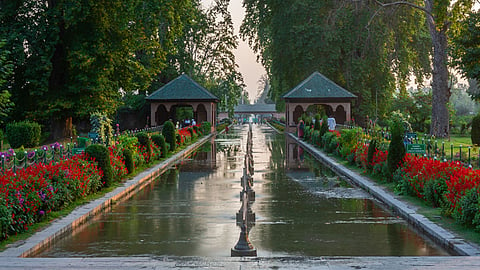
- HOMEGROWN WORLD
- #HGCREATORS
- #HGEXPLORE
- #HGVOICES
- #HGSHOP
- CAREERS
- ABOUT US
- CONTACT US

When the Mughal Emperor, Jahangir set foot in Kashmir for the first time, he said that it was “...the paradise of which priests had prophesied and poets sang". Jahangir’s words ring true even today and anyway who has been to Kashmir will testify to that fact. The beautiful landscape of Kashmir feels like heaven on earth. Complementing its natural beauty are also the Mughal gardens that have existed for centuries and add to the serenity of the region. Today let us explore the rich history behind these gardens, particularly the largest Mughal garden in Kashmir, Shalimar Bagh, located on the bank of the tranquil Dal Lake.
Before the advent of Islam, Kashmir was primarily a Hindu region. The concept of pleasure gardens was not unknown to the region even during that period. Influenced by the concepts of vatikas (or wooded pleasure gardens), of ancient India, a variety of such gardens were created in the valley mostly in the form of orchards. These gardens were adorned with a variety of flowers, herbs, and aromatic plants. They were later maintained by succeeding Muslim rulers, although the gardens underwent several changes over the years.
Islam came to Kashmir in the 14th century with the establishment of the Shahmiri Sultanate in the region. Some of the prominent leaders of the new dynasty were immigrants from Persia or regions with a heavy Persian influence. As a result, along with language, dress, and customs, many types of arts and crafts linked to Persia also flourished in the region. Chiefly among them was the art of gardening.
Before the Mughals established their foothold in Kashmir in the 16th century, it was already home to various ruling dynasties beginning with the ancient Hindu kings to the Shahmiris and the Chaks. Kashmir had, however, always been on the minds of the Mughal emperors. The sheer beauty of the place along with its prospects of being a wonderful site for their favorite hobby of laying out pleasure gardens would have fascinated them.
The renowned Mughal gardens of Kashmir owe their grandeur primarily to Emperor Jahangir and his son Shah Jahan, who shared his father’s immense love for gardening. Jahangir was responsible for the careful selection of the site and maneuvering it to suit the requirements of the traditional paradise gardens. Although the Mughals never deviated too much from the original form or concept of the gardens, their biggest challenge in Kashmir was to use the chosen site and the abundance of water resources to their full potential.
Emperor Jahangir is said to be the creator of the lower garden of Shalimar Bagh around 1620. Origins of the Shalimar Bagh go back to the sixth century when the garden was a sacred site. Jahangir brought the garden to the peak of its glory. The construction was overseen by his son and like most Mughal gardens, it was also developed along the lines of the traditional chahar bagh concept (Chahar Bagh is a Persian and Indo-Persian quadrilateral garden layout based on the four Gardens of Paradise mentioned in the Quran). After Shah Jahan ascended the throne, he added the Fayz Bakhsh, the 'Bounty-Bestowing' garden, or the zenana (zenana is the part of the garden meant to be used only by royal ladies) to the earlier Farah Bakhsh at Shalimar Bagh. Zafar Khan, the Mughal governor of Kashmir built the remarkable black marble pavilion in Shalimar Bagh’s zenana.
The present size of the garden measures approximately 594 x 250 m and has five main terraces that constitute two and a half chahar baghs. The whole royal garden was divided into two major parts as per the requirement of the royalty. The lower portion, comprising the first three terraces is the Diwan-i-Aam, where the emperor used to hold public audiences. The upper two terraces were exclusively for the Emperor and his courtiers and thus, aptly named Diwan-i-Khas. These two parts were screened by a thick masonry wall having two similar gateways and that area was the zenana.
The garden has a total of six watch towers at each of its four corners and also in the middle. Even though the original Mughal planting scheme has worn out over the years, the garden is still lush with, flowers, well-mowed turf, and some fruit trees. The outstanding quality of Shalimar Bagh lies in the synthesis of its landscape and architectural features. The wider setting of the rural agricultural landscape, the rice fields and hamlets, the historic canal that links the garden to Dal Lake, and the mountain backdrop, all contribute to the significance of Shalimar Bagh.
The Shalimar Bagh is a testimony to the rich Mughal lifestyle and the abode where the Mughal court escaped every summer, from the scorching heat of the Indian plains. With a distinguished history, the gardens of Shalimar Bagh are amongst the very few surviving authentic Mughal gardens. It is a must-visit for all.
